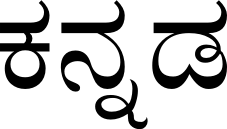Language/Kannada/Grammar/Past-Tense
As we continue our journey to learn Kannada, we come across the need to express actions that have already happened in the past. In this lesson, we will learn how to conjugate Kannada verbs in the past tense, including regular and irregular verbs.
Regular Verbs
Regular verbs in Kannada are formed by adding the suffix "-ದ್ದು (-addu)" to the present stem. The present stem is obtained by removing the "-ರು (-aru)" suffix from the infinitive form of the verb. Here is an example:
| Kannada | Pronunciation | English |
|---|---|---|
| ಮಾಡುವ | māḍuva | to do |
| ಮಾಡುತ್ತಿರುವ | māḍuttiruva | doing |
| ಮಾಡಿದ | māḍida | did |
As you can see in the example, we take the infinitive form of the verb "to do" which is "ಮಾಡುವ (māḍuva)" and remove the "-ರು (-aru)" suffix to get the present stem "ಮಾಡುತ್ತಿರುವ (māḍuttiruva)". Finally, we add the past tense suffix "-ದ್ದು (-addu)" to get the past tense "ಮಾಡಿದ (māḍida)" which means "did".
Let's look at some more examples of regular verbs in the past tense:
| Kannada | Pronunciation | English |
|---|---|---|
| ಹೇಳಿದ | hēḷida | said |
| ಬರೆದ | bareḷida | wrote |
| ಓದಿದ | ōdida | read |
| ಬಾಯ್ದಿದೆ | bāydidu | opened |
In all these examples, we simply take the present stem of the verb and add the past tense suffix "-ದ್ದು (-addu)" to get the past tense form.
Irregular Verbs
There are some verbs in Kannada that do not follow the regular pattern in the past tense. These verbs have to be memorized separately. Here are some examples:
| Kannada | Pronunciation | English |
|---|---|---|
| ಹೊರಟುಹೋಗಿದ್ದೇನೆ | horatu hōgidde ne | left |
| ಇರುತ್ತಿದ್ದೆ | iruttide | was |
| ಕೆಲಸಕ್ಕೆ ಬಂದು ಕುಳಿತುಕೊಂಡಿದ್ದೇನೆ | kelasa kku bandu kuḷitukoṇḍide ne | worked (literally means "came to work and sat down") |
As you can see from these examples, irregular verbs have unique past tense forms that cannot be derived using the regular pattern.
Negation in the Past Tense
Negating verbs in the past tense is very simple in Kannada. To form the negative past tense, we simply add the word "ಇಲ್ಲವೇ (-illavē)" after the verb in the past tense form. For example:
| Kannada | Pronunciation | English |
|---|---|---|
| ಮಾಡಲಿಲ್ಲ | māḍallilla | did not do |
| ಹೇಳಿರಲಿಲ್ಲ | hēḷirallilla | did not say |
| ಬರೆಯಲಿಲ್ಲ | bareyalilla | did not write |
Conclusion
In this lesson, we have learned how to conjugate Kannada verbs in the past tense, including regular and irregular verbs. We have also seen how to negate verbs in the past tense. Practice these forms as much as possible to become comfortable with expressing past actions and events in Kannada.

